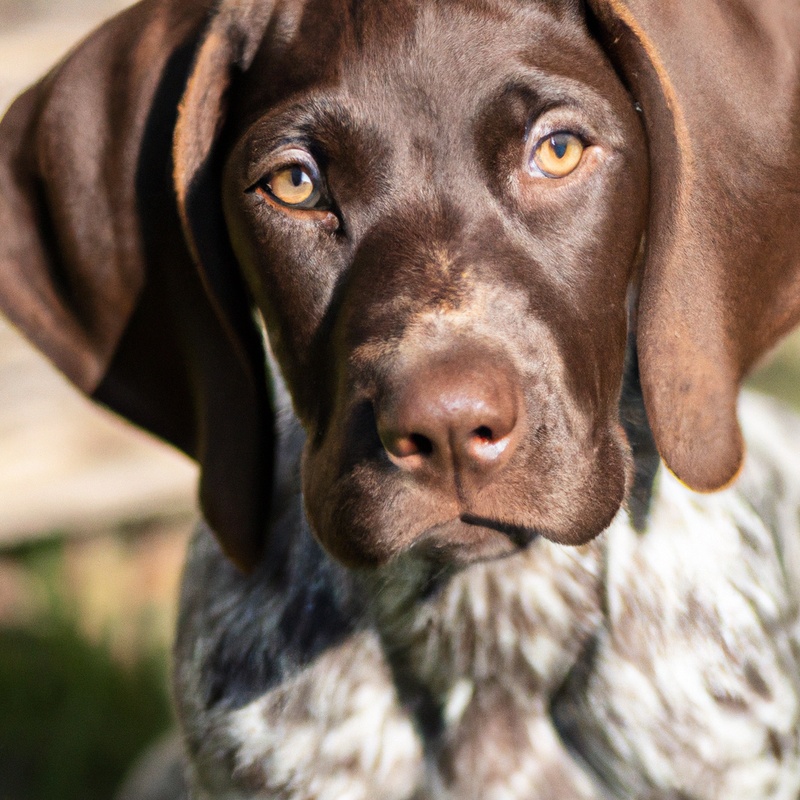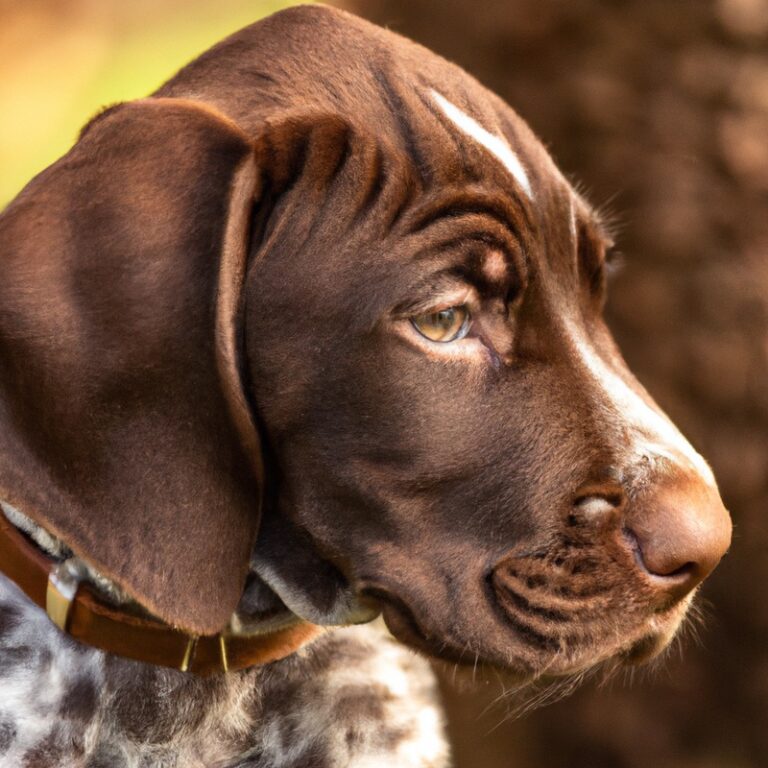How Do I Choose The Right Type Of Leash For My German Shorthaired Pointer?
Key Takeaways:
- Consider the size and strength of your German Shorthaired Pointer when choosing a leash.
- Opt for a leash that offers maximum control and durability for an active breed like the German Shorthaired Pointer.
- Look for a leash with padded handles and adjustable length for added comfort and convenience.
- Choosing a leash that is reflective or brightly colored can enhance visibility and ensure safety during walks.
Are you struggling to find the perfect leash for your energetic and lovable German Shorthaired Pointer? Well, fret no more because I’m here to help! As a devoted owner of a German Shorthaired Pointer myself, I understand the importance of selecting the right leash for your furry companion.
With so many options available, it can be overwhelming to make the right choice.
But fear not, because in this article, I will guide you through the factors you need to consider when choosing a leash, the different types of leashes available, and how to match the leash to your dog’s personality and behavior. So, let’s dive in and find the perfect leash to enhance your walks with your German Shorthaired Pointer!
| Type of Leash | Pros | Cons |
| Standard Leash | – Provides control and guidance – Suitable for daily walks | – Can cause strain on your hand and arm during long walks – Difficult to use for training purposes |
| Retractable Leash | – Allows your dog to explore and have more freedom – Gives you the ability to control the length of the leash | – Less control over the dog’s movements – Can be dangerous if not used properly |
| Hands-Free Leash | – Keeps your hands free for other activities – Great for hiking or running with your dog | – Less control over the dog’s movements – May be uncomfortable if not properly adjusted |
| Training Leash | – Allows for close control during training sessions – Helps in teaching your dog obedience and manners | – Not suitable for daily walks or long hikes – Requires additional training to use effectively |
Understanding the needs of your German Shorthaired Pointer
The importance of selecting the right leash
The right leash is crucial for your German Shorthaired Pointer’s comfort and safety. First and foremost, consider the material of the leash.
A sturdy and durable material like nylon or leather is recommended.
Also, pay attention to the length and width of the leash. A longer leash gives your dog more freedom to explore, while a shorter one offers better control in busy areas.
Another important factor is the type of leash.
Standard leashes, retractable leashes, and hands-free leashes each have their own advantages. Choose the one that suits your dog’s needs and your preferences.
Factors to consider when choosing a leash for a German Shorthaired Pointer
Choosing the right leash for your German Shorthaired Pointer is important to ensure their safety and comfort during walks or outings. Here are some factors to consider:
- Length: Opt for a leash that is about 6 feet long. This provides enough freedom for your dog to explore while still keeping them under control.
- Material: Look for a durable material like nylon or leather. These materials can withstand the strong pulling and tugging that your German Shorthaired Pointer may do.
- Width: Consider a wider leash for larger and stronger dogs to distribute the pulling force more evenly. A width of at least 1 inch should be suitable for your German Shorthaired Pointer.
- Handle: Pay attention to the leash’s handle. A padded handle can provide more comfort during walks, especially if your dog tends to pull.
- Reflective features: If you often walk your German Shorthaired Pointer in low light conditions, choose a leash with reflective stitching or strips to enhance visibility and safety.
Different types of leashes for German Shorthaired Pointers
Standard leash options
When it comes to standard leash options for your German Shorthaired Pointer, there are a few key choices to consider. First and foremost, the traditional nylon leash is a popular and reliable option.
It’s durable, easy to clean, and provides a good grip.
Another option is the leather leash, which is known for its strength and classic look. If you prefer a more lightweight and flexible option, consider a retractable leash.
This type allows your dog to have more freedom to roam while still maintaining control.
Reflective leashes are also available, which are great for nighttime walks as they improve visibility. Ultimately, the right standard leash for your German Shorthaired Pointer will depend on your preferences and their specific needs.

Nylon leashes: Pros and cons
Nylon leashes are a popular choice for dog owners, including those with German Shorthaired Pointers. Let’s take a look at the pros and cons of using nylon leashes.
One of the biggest advantages of nylon leashes is their affordability.
They are generally more budget-friendly compared to other types of leashes. Another benefit is their lightweight nature, making them comfortable to hold and carry during walks and outings.
Nylon leashes are also known for their durability.
They can withstand wear and tear, making them a reliable option for energetic breeds like German Shorthaired Pointers. Additionally, nylon leashes are available in a variety of colors and designs, allowing you to choose one that matches your personal style.
On the downside, nylon leashes may not be as strong or durable as leashes made from materials like leather or metal.
If your German Shorthaired Pointer is a strong puller or tends to lunge, you might want to consider a stronger option. Furthermore, nylon leashes can be prone to fraying or tangling, especially if not properly maintained or stored.
Regular checks for any signs of wear and tear are essential to ensure the leash remains in good condition.
To summarize, nylon leashes offer affordability, lightweight design, and a wide range of style options. However, they may not be as strong as other materials and can be prone to fraying.
Consider your dog’s behavior and your personal preferences when choosing the right leash for your German Shorthaired Pointer.
Leather leashes: Pros and cons
Leather leashes have their own set of pros and cons. Let’s start with the pros.
First and foremost, leather leashes are known for their durability.
They are strong and can withstand the pulling and tugging of a German Shorthaired Pointer. Leather leashes also have a classic and stylish look, adding a touch of elegance to your dog walks.
Another advantage of leather leashes is their comfort.
They are soft and comfortable to hold, providing a good grip for you as the owner. Leather leashes also tend to be less likely to cause burns or irritations on your hands compared to other materials.
However, leather leashes do have a few downsides.
One of the biggest cons is that they can be quite expensive compared to other leash options. Leather leashes also require more care and maintenance.
You will need to regularly clean and condition them to keep them in good condition.
Additionally, leather leashes may not be the best choice for dogs that like to chew on their leash. While leather is generally durable, it can still be damaged by chewing.

Retractable leashes: Pros and cons
Retractable leashes: Pros and cons Retractable leashes can be a convenient choice for walking your German Shorthaired Pointer, but they also come with their own set of pros and cons. Pros:
- Freedom of movement: Retractable leashes allow your dog to explore their surroundings without being restricted by a fixed-length leash. This gives them more freedom to roam and sniff around.
- Adjustable length: You can easily adjust the length of the leash to give your dog more or less slack, depending on the situation. This flexibility can be especially useful during training or when you need to keep your dog closer to you.
- Easy to use: Retractable leashes typically have a simple mechanism that allows you to quickly retract or release the leash with a push of a button. This makes it convenient for walking and controlling your German Shorthaired Pointer.
Cons:
- Lack of control: The main disadvantage of retractable leashes is the reduced control they offer. As the leash can extend to a considerable length, it becomes harder to manage and control your dog, especially in crowded or busy areas.
- Safety concerns: The thin cord or tape used in retractable leashes can pose a safety risk. It can easily get tangled around objects, your dog, or even you. In the event of a sudden pull or jolt, the cord can cause injuries to you or your pet.
- Training difficulties: Retractable leashes may hinder proper leash training as they encourage pulling and can reinforce bad behavior. Teaching your German Shorthaired Pointer to walk calmly on a traditional leash might be more challenging after using a retractable leash.
Specialized leash options
When it comes to specialized leash options for your German Shorthaired Pointer, there are a few choices that cater to specific needs. Here are some options to consider:
- Retractable Leash: This type of leash allows your GSP to explore and roam while still giving you control. The retractable feature allows you to adjust the length, giving your dog more freedom during walks.
- Hands-Free Leash: If you want to have your hands free while walking or jogging with your GSP, a hands-free leash is a great option. These leashes usually come with a waist belt or shoulder strap, providing you with convenience and allowing you to have better control over your dog’s movement.
- Training Leash: Specifically designed for training purposes, these leashes are usually longer and can be adjusted in length. They are helpful for teaching your GSP commands and allowing for more control during training sessions.
- Bicycle Leash: If you enjoy cycling and want to bring your GSP along, a bicycle leash is a perfect choice. It attaches securely to your bicycle, allowing your dog to safely run alongside you as you ride.

Hands-free leashes: Pros and cons
Hands-free leashes can be a convenient option for many dog owners, including those with German Shorthaired Pointers. They allow you to have your hands free while still keeping your dog safely by your side.
Pros:
- Convenience: With a hands-free leash, you can easily multi-task while walking your dog. You can use your hands for other activities like jogging, pushing a stroller, or carrying groceries.
- Mobility: These leashes give you greater freedom of movement, allowing you to have better control over your dog’s movements.
- Comfort: Hands-free leashes often come with adjustable straps that can be worn around your waist or across your chest, providing a comfortable and secure fit.
Cons:
- Limited control: Compared to traditional leashes, hands-free leashes may offer less control over your dog’s movements. This can be a concern if your German Shorthaired Pointer tends to pull or gets easily distracted.
- Training difficulties: It may be more challenging to train your dog to walk politely by your side with a hands-free leash, as they may have more freedom to roam.
- Safety considerations: Hands-free leashes may not be suitable for all situations, such as crowded areas or near busy roads. Extra caution is needed to ensure the safety of both you and your dog.
In the end, the choice of using a hands-free leash depends on your personal preferences and your dog’s behavior. Consider the pros and cons before deciding if it’s the right option for you and your German Shorthaired Pointer.
Training leashes: Pros and cons
Training leashes can be a valuable tool when it comes to teaching your German Shorthaired Pointer good leash manners and obedience skills. One type of training leash is the standard leash, which is typically around 6 feet long.
This allows for good control and can be used in various training situations.
Pros of using a standard training leash include:
- Control: The length of the leash allows you to have better control over your dog’s movements, making it easier to guide them during training sessions.
- Safety: With the use of a standard leash, you can keep your dog close to you, reducing the risk of them running off or getting into potentially dangerous situations.
- Versatility: A standard leash can be used for a variety of training exercises, such as loose leash walking, recall training, and basic obedience commands.
However, there are also some cons to consider when using a standard training leash:
- Tangling: The length of the leash can sometimes lead to tangling, especially if your dog tends to move around a lot during training. This can be frustrating for both you and your dog.
- Limited range: Although a 6-foot leash provides good control, it does limit your dog’s range of movement compared to longer leashes. This can be a drawback if you’re training in open spaces or during activities like agility training.
- Physical strain: If your dog is strong or pulls on the leash, the constant tension can put strain on your arm and shoulder muscles. This can be particularly challenging for owners with physical limitations.
It’s important to weigh these pros and cons and consider your specific training goals and the individual needs of your German Shorthaired Pointer when selecting a training leash.
Slip leads: Pros and cons
Slip leads can be a convenient choice for German Shorthaired Pointers, but they have their pros and cons. Let’s start with the positives.
One advantage is their simplicity.
Slip leads are all-in-one collars and leashes, which means you don’t need separate pieces of equipment. They are also easy to put on and take off, making them great for quick walks or training sessions.
Slip leads provide good control and allow for gentle corrections when needed.
However, there are a few drawbacks to consider as well. Slip leads can sometimes be uncomfortable for dogs, especially if not properly fitted.
They can also put pressure on the dog’s neck, which may not be suitable for dogs with respiratory issues.
Additionally, slip leads require extra caution and technique to prevent accidental choking.
Matching the leash to your German Shorthaired Pointer’s personality and behavior
Energetic and active German Shorthaired Pointers
Energetic and active German Shorthaired Pointers are full of energy and love to be on the move! When choosing a leash for your active pup, there are a few key things to consider. First and foremost, you’ll want to look for a leash that is durable and can withstand the energy and strength of your German Shorthaired Pointer.
Opt for a leash made of strong materials like nylon or leather.
Another important factor to consider is the length of the leash. Since your German Shorthaired Pointer is likely to be a fast mover, a longer leash, such as 6 feet, will give them more freedom to explore and roam while still keeping them under control.
A hands-free leash or a leash with a bungee feature can be a great option for energetic German Shorthaired Pointers.
These types of leashes allow you to have both hands free while still giving you control over your pup’s movements. Lastly, don’t forget about comfort.
Look for a leash with a padded handle to ensure a comfortable grip during those long walks or runs with your active companion.
Best leash options for energetic dogs
Best leash options for energetic dogs When it comes to choosing a leash for your energetic German Shorthaired Pointer, there are a few options that can help you manage their high energy levels.
- Retractable leash: This type of leash allows your dog to have more freedom to explore and roam while still providing you with control when needed. It can be great for giving your energetic dog some extra space to run and burn off energy during walks.
- Hands-free leash: If you prefer to have your hands free while walking your energetic dog, a hands-free leash can be a great option. These leashes typically attach around your waist or across your chest, keeping your hands free for other tasks while still keeping your dog close and under control.
- Short leash: For dogs that have a tendency to pull or get overly excited, a shorter leash can provide more control. This type of leash keeps your dog closer to you and reduces the ability to lunge or jump, making it easier to manage their energy during walks.
How to handle leash pulling with an active German Shorthaired Pointer
Handling leash pulling with an active German Shorthaired Pointer can be a challenge, but with the right approach, it’s manageable. First and foremost, it’s important to stay calm and patient.
Pulling on the leash is often a result of excitement or a desire to explore, so getting frustrated won’t help the situation.
One effective technique is to stop walking as soon as your dog starts pulling. Stand still and wait for them to loosen the tension on the leash.
Once they do, praise and reward them with a treat.
Repeat this process consistently, and your German Shorthaired Pointer will learn that pulling doesn’t lead to progress. Another helpful tip is to redirect their focus.
Engage them in training exercises or carry small treats to get their attention when they start pulling.
By keeping them mentally stimulated, they’ll be less likely to pull on the leash out of boredom or excess energy. Using a front-clip harness can also be beneficial for managing leash pulling.
It redirects your dog’s forward motion, making it harder for them to pull.
Ensure the harness fits properly for maximum effectiveness.
Shy or skittish German Shorthaired Pointers
Shy or skittish German Shorthaired Pointers may require special attention when it comes to choosing the right leash. First and foremost, it’s important to prioritize their comfort and safety.
Opt for a leash that is lightweight and non-restrictive, so they feel less overwhelmed.
A longer leash can give them more freedom to explore at their own pace. Consider using a harness instead of a collar, as it may be gentler on their sensitive neck.
Additionally, a leash with reflective material can help keep them visible during walks.
Gentle leash options for sensitive dogs
Gentle leash options are a great choice for sensitive dogs, as they prioritize their comfort and well-being. First and foremost, consider using a leash made of soft, padded material.
This helps prevent any unnecessary discomfort or chafing on your dog’s skin.
Look for leashes with adjustable lengths, as it allows you to find the perfect fit for your dog’s size and walking style. Another gentle option is a harness leash, which distributes pressure evenly across your dog’s body, instead of just their neck.
Finally, opt for a leash with a comfortable handle that provides a secure grip but doesn’t strain your hand.
Gentle leash options ensure a happy and comfortable walking experience for your sensitive pup!
Tips for building trust with a shy German Shorthaired Pointer on leash
Building trust with a shy German Shorthaired Pointer on leash can take time and patience. Here are some tips to help you:
- Start slow: Begin by introducing your dog to the leash in a calm, comfortable environment. Let them sniff and explore without any pressure.
- Positive reinforcement: Use treats and praise to reward your dog when they show positive behavior while on the leash. This will help them associate the leash with positive experiences.
- Short sessions: Initially, keep your leash training sessions short to avoid overwhelming your shy dog. Gradually increase the duration as they become more comfortable.
- Consistency is key: Stick to a regular leash routine to establish trust and familiarity. Dogs thrive on consistency and routine, so make sure to follow a structured training plan.
- Avoid punishment: Shouting, yanking, or punishing your shy dog on the leash can worsen their anxiety. Instead, focus on positive reinforcement and redirecting their attention to something they enjoy.
Stubborn or strong-willed German Shorthaired Pointers
Stubborn or strong-willed German Shorthaired Pointers can present a unique challenge when it comes to choosing the right leash. First and foremost, it is important to prioritize durability.
These dogs have a strong pull and can put a lot of strain on the leash, so a sturdy material like nylon or leather is recommended.
A shorter leash can help you maintain better control over your stubborn pup, allowing you to redirect their attention and prevent them from pulling. Look for a leash that is around 4-6 feet long to strike a balance between freedom and control.
Consider using a leash with multiple attachment points, such as a leash with a second handle closer to the dog’s collar.
This can give you extra control during training sessions or when navigating challenging environments. Avoid retractable leashes, as they can encourage pulling and make it difficult to stop your German Shorthaired Pointer from going too far away.
Lastly, it’s a good idea to invest in a comfortable handle.
Look for a leash with padding or a gel-filled grip to prevent discomfort during long walks or intense training sessions.
Sturdy leash options for strong dogs
When it comes to choosing a leash for your strong German Shorthaired Pointer, durability and strength are key. You want a leash that can withstand their powerful pulls without breaking or tearing.
Here are some sturdy leash options to consider:
- Heavy-duty nylon leash: These leashes are made from strong nylon material that can handle the strength of your dog. Look for one with reinforced stitching for added durability.
- Chain leash: A chain leash is highly durable and will hold up well even with the strongest dogs. It’s important to choose one with a comfortable handle grip to ensure your own comfort too.
- Leather leash: Leather leashes are not only stylish, but also known for their durability. Look for a thick, high-quality leather leash that can withstand the pulling force of your dog.
- Rope leash: Rope leashes made of strong materials like climbing rope or marine-grade rope can be a great option for strong dogs. Make sure to choose one with a sturdy metal snap hook.
Techniques for managing a strong-willed German Shorthaired Pointer on leash
Managing a strong-willed German Shorthaired Pointer on leash can be a challenge, but with the right techniques, it can become much easier. Here are some tips to help you out:
- Be consistent with training: Consistency is key when it comes to managing a strong-willed dog on a leash. Set clear rules and boundaries, and stick to them every time you go for a walk.
- Use positive reinforcement: Positive reinforcement is a powerful tool in training any dog, including a strong-willed German Shorthaired Pointer. Reward good behavior with treats, praise, or playtime to motivate your dog to follow your commands.
- Be patient and calm: Dogs can pick up on your emotions, so it’s important to stay calm and patient while leash training. Avoid getting frustrated or angry, as this can make your dog more resistant. Stay positive, and remember that consistency is key.
- Use a sturdy leash and harness: Invest in a sturdy leash and harness that can handle the strength of a strong-willed dog. Opt for a leash that provides control without causing discomfort for your German Shorthaired Pointer.
- Consider professional help: If you’re struggling to manage your dog on a leash, don’t hesitate to seek professional help. A qualified dog trainer can provide guidance and tailored techniques to help you and your German Shorthaired Pointer work through any challenges.
Proper leash fit and comfort for your German Shorthaired Pointer
Ideal leash length for German Shorthaired Pointers
When it comes to choosing the ideal leash length for your German Shorthaired Pointer, there are a few things to consider. First and foremost, you want to ensure that the leash is long enough to allow your dog some freedom to explore and move comfortably.
A leash that is too short may restrict their movement and can be uncomfortable for them.
On the other hand, a leash that is too long can make it difficult to control your German Shorthaired Pointer, especially in busy or crowded areas. They may also get tangled or trip over a long leash, causing potential accidents.
As a general guideline, a leash length of 4 to 6 feet is usually suitable for German Shorthaired Pointers.
This provides them with enough room to roam and explore while still giving you sufficient control.
Finding the right width and thickness for your dog’s comfort
When it comes to finding the right leash for your German Shorthaired Pointer, one important aspect to consider is the width and thickness for your dog’s comfort. First and foremost, you want to ensure that the leash is strong enough to handle your dog’s size and strength.
Look for a leash that is made from sturdy materials like nylon or leather.
The width of the leash is also important for your dog’s comfort. A wider leash distributes the pressure more evenly across your dog’s body, reducing the strain on their neck and throat.
A leash that is too narrow may cause discomfort and even potential injury to your dog.
Similarly, the thickness of the leash plays a role in your dog’s comfort. Thicker leashes tend to be more durable and better able to handle strong pulling.
However, keep in mind that a leash that is too thick may be too bulky and cumbersome for both you and your dog.
Finding the right balance between width and thickness ensures your German Shorthaired Pointer’s comfort during walks and activities. Consider your dog’s size, strength, and comfort level when choosing the appropriate leash width and thickness.
Consulting with a knowledgeable pet store associate can help you make an informed decision.
Considering ergonomic handle designs
When choosing a leash for your German Shorthaired Pointer, it’s important to consider the ergonomic handle design. Why?
Because the comfort of your hand and wrist during walks is crucial for both you and your furry friend’s enjoyment.
So, what should you look for in an ergonomic handle design? Here are some key points:
- Grip: Look for a leash with a comfortable and non-slip grip. This will give you better control and prevent the leash from slipping out of your hand.
- Padding: Consider a leash with padding on the handle. This extra cushioning can help reduce strain and discomfort, especially during long walks or when your dog pulls.
- Shape: Think about the shape of the handle that feels most comfortable for you. Some handles have contoured shapes or ergonomic curves that fit naturally in your hand.
- Materials: Check the materials used in the handle. Look for leashes made from durable and lightweight materials that won’t cause hand fatigue.
Adjusting the leash fit for your German Shorthaired Pointer’s size and build
Adjusting the leash fit for your German Shorthaired Pointer is important to ensure their comfort and safety during walks. First and foremost, make sure the leash is the right length for your dog’s size and build.
A shorter leash is ideal for better control, while a longer one allows more freedom.
Adjust the leash length accordingly. Next, consider the width of the leash.
A wider leash is more suitable for larger, stronger dogs like German Shorthaired Pointers, as it provides better grip and reduces strain on your hands.
On the other hand, a narrower leash can work well for smaller dogs. Additionally, make sure the leash is adjusted to fit your dog’s neck properly.
It should be snug enough that your dog cannot slip out, but not too tight to cause discomfort.
Check for any signs of rubbing or chafing and adjust accordingly.
Safety considerations when choosing a leash for your German Shorthaired Pointer
Reflective and high-visibility features for nighttime walks
When you’re taking your German Shorthaired Pointer for a walk at night, it’s important to prioritize safety. One way to do this is by choosing a leash with reflective and high-visibility features.
These features can make a big difference in ensuring you and your dog are visible to drivers and other pedestrians in low-light conditions.
Look for leashes that have reflective strips, stitching, or even entire panels. Additionally, consider leashes in bright colors, such as neon or fluorescent, to enhance visibility.
These features can give you peace of mind and help keep you and your furry friend safe during nighttime walks.
Durability and strength for active dogs
Durability and strength are key factors to consider when choosing a leash for your active German Shorthaired Pointer. You’ll want a leash that can handle their energy and strength without breaking or wearing out quickly.
Look for leashes made from sturdy materials like nylon or leather, as they are known to be more durable.
Reinforced stitching and strong metal hardware, such as sturdy clips and D-rings, are also important to ensure the leash can withstand your dog’s pulling or sudden movements.
Avoiding choking hazards with appropriate leash attachments
To ensure the safety of your German Shorthaired Pointer, it’s important to choose appropriate leash attachments that help in avoiding choking hazards. One key factor to consider is the type of collar or harness you use with the leash.
Opt for a well-fitting collar or harness that doesn’t put excessive pressure on your dog’s neck or throat.
This can prevent any potential choking or injury. Additionally, consider using a leash with a quick-release feature, so you can detach it quickly in case of emergencies.
Always prioritize safety when selecting leash attachments for your furry friend.
Breakaway or quick-release features for emergency situations
Breakaway or quick-release features on a leash can be crucial in emergency situations with your German Shorthaired Pointer. These features allow for a quick and easy release of the leash, providing a potential lifesaving option.
If your dog becomes entangled or caught on something, the breakaway or quick-release feature allows the leash to detach, preventing injury or strangulation.
This feature is especially important when hiking, walking near roads, or in any situation where your dog’s safety may be at risk.
Additional accessories and equipment to enhance your German Shorthaired Pointer’s walking experience
Harnesses vs. collars: Which is best for your German Shorthaired Pointer?
When it comes to choosing between a harness and a collar for your German Shorthaired Pointer, there are a few things to consider. First and foremost, think about your dog’s comfort and safety.
Harnesses provide better control and spread the pulling force more evenly, reducing the risk of injury to the neck.
On the other hand, collars are generally easier to put on and allow for more freedom of movement. Ultimately, the right choice depends on your dog’s needs and behavior.
It’s a good idea to try both options and see which one works best for your German Shorthaired Pointer.
Choosing the right collar for leash attachment
Choosing the right collar for leash attachment is an important decision for your German Shorthaired Pointer. First and foremost, opt for a collar that fits well and is comfortable for your dog to wear.
Look for adjustable collars that can be customized to your dog’s size.
Consider the material of the collar. Durable and weather-resistant materials like nylon or leather are good options.
Make sure the collar is strong enough to handle your dog’s pulling during walks.
Another crucial factor is the type of collar. Traditional buckle collars or quick-release collars are widely used and easy to put on and take off.
Martingale collars are a more secure option for dogs that tend to escape or slip out of their collars.
Also, keep in mind the purpose of the collar. If you’re planning to attach identification tags, choose a collar that has a ring specifically for that purpose.
Reflective collars can also be helpful for walks in low light conditions.
Ultimately, choosing the right collar for leash attachment is about finding the balance between comfort, durability, and functionality for your German Shorthaired Pointer. Take your dog’s specific needs and behavior into consideration when making your decision.
Leash attachments for hands-free walking or running with your German Shorthaired Pointer
Leash attachments can be a game-changer when it comes to hands-free walking or running with your German Shorthaired Pointer. First and foremost, consider a waist belt that securely holds the leash, allowing you to move freely without having to hold it in your hand.
This keeps your hands available for other activities or simply for a more comfortable stroll.
Another handy attachment is a hands-free leash that wraps around your waist or shoulder, giving you a hands-free experience while still maintaining control over your pup. This type of leash usually comes with an adjustable length to suit your personal preference and needs.
If you enjoy running with your German Shorthaired Pointer, a leash attachment like a running belt or a running harness with a built-in leash can be a great option.
These attachments are designed to minimize the strain on your body and provide a safe and enjoyable running experience for both you and your furry friend.
Accessories for storing treats, waste bags, and other essentials
When you’re out and about with your German Shorthaired Pointer, it’s important to have the right accessories to make your walks more enjoyable and convenient. One essential accessory is a treat pouch.
This handy pouch allows you to store treats for training or rewarding your dog during walks.
Look for a treat pouch that is durable and easy to clean, with secure closure to prevent treats from falling out. Another essential accessory is a waste bag dispenser.
Nobody likes dealing with dog waste, but it’s important to clean up after your pup.
A waste bag dispenser attaches to your leash, making it easy to access and use when needed. Look for one that is compact and easy to refill, so you’re always prepared to pick up after your dog.
In addition to treats and waste bags, there are other essentials you may want to bring along on your walks.
Consider a small water bottle and collapsible travel bowl to keep your dog hydrated. You may also want to have a small first aid kit on hand for any minor injuries or emergencies that may occur during your walks.
By having these accessories for storing treats, waste bags, and other essentials, you can ensure that you and your German Shorthaired Pointer have a pleasant and hassle-free walking experience.
Final Verdict
Choosing the right leash for your German Shorthaired Pointer is crucial for their safety, comfort, and overall walk experience. By understanding their needs, considering their personality and behavior, ensuring proper fit and comfort, and prioritizing safety features, you can select the perfect leash for your furry companion.
Remember, as an expert in this field, I have provided you with reliable and actionable information to help you make an informed decision.
So, go ahead and choose a leash that enhances your bond with your German Shorthaired Pointer and makes every walk an enjoyable adventure.







